#Cheap flights to Ho Chi Minh City
Explore tagged Tumblr posts
Text
Săn vé máy bay giá rẻ cho sinh viên
Đối với sinh viên, việc di chuyển bằng máy bay có thể là một khoản chi phí lớn. Tuy nhiên, với một vài bí quyết đơn giản, bạn hoàn toàn có thể săn được vé máy bay giá rẻ và tiết kiệm được một khoản tiền đáng kể.
1 note
·
View note
Text
Seek budget-friendly travel options with enticing deals for flights to Ho Chi Minh City, Vietnam at https://www.oneair.ai/flights/cheap-flights-to-ho-chi-minh-city-vietnam/. Explore this bustling metropolis affordably.
0 notes
Text
Day 9 Hue to Ho Chi Minh City (Saigon)
Not many photos today because not much happened apart from travelling from Hue (pronounced Hway) to Ho Chi Minh by coach and plane. First the bus/coach to take us back to Da Nang airport but not via the pass. This time via the tunnel which is a lot quicker and given there is a lot of cloud cover and big rain clouds bursting occasionally, I’m glad we’re not travelling over the pass.
A quick bathroom break at the same place we stopped for lunch a couple of days earlier.


Then arriving at the airport nearly 3 hours before our flight was due to depart so we had lots of sitting around. It’s not a big airport so there weren’t lots of shops to help with passing the time. As you can see Ian was bored very quickly.


On the flight after a delayed departure, we touched down in Ho Chi Minh City not long after taking off (an hour and a bit). We piled onto the coach again to find our hotel in district 1 which means it’s pretty central. Unfortunately it doesn’t mean it’s very nice.
There are close to 15 million people living here and about 7 million motorcycles. 😳 It’s nuts. I really can’t believe we’ve not seen a collision. Phil described the motorcyclists like a school of fish. Darting in and out of every available space.
After checking in and being thoroughly disappointed with our room given they’ve been pretty good up until now, we went out to find a pre-dinner drink and then somewhere for dinner. We found another craft beer place just around the corner from the hotel so ☑️.

I meant to make another comment about the room. Phil was fiddling with the safe in our room to put our passports in but soon discovered that maybe it wasn’t all that safe. 😳😂

Needless to say we didn’t bother using it.
Dinner was also very close to our hotel and was traditional Vietnamese food. Well it was one of the best so far! Fresh, cheap and delicious. Katherine had coconut water envy after seeing Sharon with hers so she ordered one too.

Back to our small and noisy room to try and get some zzzz before tomorrow’s early start which is a tour with the group to the Chi Chi tunnels and somewhere else I can’t remember now. 😴
4 notes
·
View notes
Text
Top 10 International Budget-Friendly Destinations from India
Are you dreaming of an international trip but worried about the expenses? Don't worry! There are plenty of budget-friendly destinations from India where you can enjoy an exciting vacation without breaking the bank. From stunning beaches to vibrant cities, these destinations offer everything from breathtaking tourist attractions to thrilling nightlife and adventure activities.
In this blog, we will cover the best international destinations that are easy on the wallet while giving you the ultimate travel experience. Plus, we will provide estimated budgets and flight costs to help you plan efficiently.
Here’s a detailed guide to the top 10 international budget-friendly destinations from India, covering everything you need to plan a perfect trip.
1. Malaysia – The Perfect Blend of Nature & Modernity
Why Visit Malaysia?
Malaysia offers a perfect mix of stunning beaches, vibrant nightlife, lush rainforests, and futuristic cityscapes. From the iconic Petronas Towers in Kuala Lumpur to the pristine beaches of Langkawi, Malaysia caters to all types of travelers.
Top Tourist Attractions
Kuala Lumpur – Petronas Towers, Batu Caves, Chinatown
Langkawi Island – Sky Bridge, Underwater World, Island Hopping
Penang – George Town’s street art, Kek Lok Si Temple, Batu Ferringhi Beach
Cameron Highlands – Tea plantations, Mossy Forest, Strawberry Farms
Nightlife in Malaysia
Malaysia’s nightlife is vibrant yet affordable. Kuala Lumpur and Langkawi have buzzing rooftop bars, beach clubs, and night markets. Some must-visit places include Zouk Club Kuala Lumpur, SkyBar KL, and Pantai Cenang Beach Bars in Langkawi.
Activities to Try
Scuba diving in Langkawi
Exploring night markets in Penang
Jungle trekking in Taman Negara
Skydiving in Kuala Lumpur
Budget Breakdown
Flight Cost (Round-trip from India): ₹15,000 - ₹20,000
Daily Expenses: ₹3,000 - ₹4,500 (including food, travel, and entry fees)
Total Budget for 5 Days: ₹40,000 - ₹50,000
2. Thailand – The Ultimate Budget Party Destination
Why Visit Thailand?
Thailand is one of the most affordable international destinations for Indian travelers. Known for its pristine beaches, buzzing nightlife, and rich cultural heritage, it offers a luxurious experience at a budget price.
Top Tourist Attractions
Bangkok – Grand Palace, Floating Markets, Wat Arun
Pattaya – Coral Island, Walking Street, Sanctuary of Truth
Phuket – Phi Phi Islands, Big Buddha, Bangla Road
Chiang Mai – Doi Suthep, Elephant Sanctuaries
Nightlife in Thailand
Thailand’s nightlife is famous worldwide. Bangkok’s Khao San Road, Pattaya’s Walking Street, and Phuket’s Patong Beach are top spots for affordable yet exciting party experiences.
Activities to Try
Snorkeling at Phi Phi Islands
Floating market shopping in Bangkok
Partying at Full Moon Party in Koh Phangan
Exploring Buddhist temples and night bazaars
Budget Breakdown
Flight Cost (Round-trip from India): ₹12,000 - ₹18,000
Daily Expenses: ₹2,500 - ₹4,000
Total Budget for 5 Days: ₹35,000 - ₹45,000
3. Vietnam – A Hidden Gem for Budget Travelers
Why you should visit Vietnam?
Vietnam offers a diverse landscape with breathtaking mountains, historic towns, and scenic beaches at extremely affordable prices.
Top Tourist Attractions
Hanoi – Hoan Kiem Lake, Old Quarter, Temple of Literature
Ha Long Bay – Cruise, Kayaking, Limestone Caves
Da Nang – Golden Bridge, My Khe Beach
Ho Chi Minh City – Cu Chi Tunnels, War Remnants Museum
Nightlife in Vietnam
Vietnam has a mix of chilled beer pubs, street bars, and nightclubs in cities like Hanoi and Ho Chi Minh City. The famous Bui Vien Street in Ho Chi Minh is a backpacker's paradise for cheap drinks and parties.
Activities to Try
Ha Long Bay Cruise
Motorbike tours in Hanoi
Street food tours in Ho Chi Minh City
Exploring floating markets in Mekong Delta
Budget Breakdown
Flight Cost (Round-trip from India): ₹18,000 - ₹25,000
Daily Expenses: ₹2,500 - ₹4,000
Total Budget for 6 Days: ₹40,000 - ₹50,000
4. Almaty, Kazakhstan – A Budget-Friendly Winter Wonderland
Why you should visit Almaty?
Almaty is an offbeat yet budget-friendly destination for those who love snow-capped mountains, adventure activities, and unique Kazakh culture.
Top Tourist Attractions
Shymbulak Ski Resort
Kok Tobe Hill
Big Almaty Lake
Medeu Ice Skating Rink
Nightlife in Almaty
Almaty has a vibrant clubbing scene with affordable drinks and entertainment at clubs like Chukotka, Gan Bei, and Sky Bar.
Activities to Try
Skiing at Shymbulak
Hiking to Big Almaty Lake
Exploring local Kazakh cuisine
Budget Breakdown
Flight Cost (Round-trip from India): ₹25,000 - ₹30,000
Daily Expenses: ₹3,000 - ₹4,500
Total Budget for 5 Days: ₹50,000 - ₹60,000
5. Baku, Azerbaijan – The Dubai of the Caucasus
Why you should visit Baku?
Baku is a blend of modern skyscrapers and historical old town architecture, making it one of the most affordable European-style destinations from India.
Top Tourist Attractions
Flame Towers
Maiden Tower
Heydar Aliyev Center
Gobustan National Park
Nightlife in Baku
Baku has an underrated but lively nightlife with many affordable clubs, rooftop bars, and lounges.
Activities to Try
Fire Mountain Tour
Caspian Sea Cruise
Wine tasting in vineyards
Budget Breakdown
Flight Cost (Round-trip from India): ₹22,000 - ₹30,000
Daily Expenses: ₹3,000 - ₹4,500
Total Budget for 5 Days: ₹45,000 - ₹55,000
6. Bali, Indonesia – The Affordable Tropical Paradise
Why you should visit Bali?
Bali is a dream destination for Indian travelers looking for a tropical getaway at budget-friendly prices. From scenic rice terraces and ancient temples to beach parties and adventure sports, Bali has something for everyone.
Top Tourist Attractions
Ubud – Tegalalang Rice Terraces, Monkey Forest, Ubud Art Market
Seminyak & Kuta – Beach clubs, nightlife, shopping streets
Nusa Penida – Kelingking Beach, Broken Beach, Angel’s Billabong
Mount Batur – Sunrise trekking & hot springs
Nightlife in Bali
Bali is famous for its beach parties, rooftop bars, and vibrant nightlife. Popular places include Potato Head Beach Club, Sky Garden, and La Favela in Seminyak.
Activities to Try
Surfing in Canggu
Snorkeling in Nusa Penida
Temple tour in Uluwatu
ATV rides in Ubud’s jungle
Budget Breakdown
Flight Cost (Round-trip from India): ₹20,000 - ₹30,000
Daily Expenses: ₹3,000 - ₹4,500
Total Budget for 6 Days: ₹45,000 - ₹55,000
7. Dubai, UAE – Luxury on a Budget
Why you should visit Dubai?
Dubai is a mix of modern skyscrapers, desert adventures, and luxurious experiences. Despite being known for its luxury, it offers budget-friendly travel options for Indian tourists.
Top Tourist Attractions
Burj Khalifa & Dubai Mall
Palm Jumeirah & Atlantis The Palm
Desert Safari & Dune Bashing
Dubai Creek & Old Souk Markets
Nightlife in Dubai
Dubai has a diverse nightlife scene, from exclusive rooftop lounges to traditional Arabic cafes. Popular places include White Dubai, Barasti Beach Bar, and Billionaire Mansion.
Activities to Try
Dune bashing & camel riding
Shopping at Dubai’s Gold Souk
Exploring Global Village & Miracle Garden
Yacht cruise in Dubai Marina
Budget Breakdown
Flight Cost (Round-trip from India): ₹18,000 - ₹25,000
Daily Expenses: ₹4,000 - ₹6,000
Total Budget for 5 Days: ₹55,000 - ₹65,000
8. The Philippines – A Tropical Gem for Budget Travelers
Why you should Visit Philippines?
The Philippines is a paradise of over 7,000 islands known for crystal-clear waters, white sand beaches, and rich marine life. It’s an affordable tropical destination that offers diverse experiences.
Top Tourist Attractions
Palawan – El Nido, Underground River, Nacpan Beach
Boracay – White Beach, Island Hopping, Scuba Diving
Cebu – Kawasan Falls, Whale Shark Diving, Chocolate Hills
Manila – Intramuros, Rizal Park, Ocean Park
Nightlife in the Philippines
The Philippines has beach bars, live music lounges, and party islands. Boracay’s Station 2 Beach Bars and Manila’s Makati District are top nightlife spots.
Activities to Try
Snorkeling in Coron’s Shipwrecks
Partying at Boracay’s White Beach
Island hopping in El Nido
Swimming with whale sharks in Cebu
Budget Breakdown
Flight Cost (Round-trip from India): ₹25,000 - ₹35,000
Daily Expenses: ₹3,500 - ₹5,000
Total Budget for 6 Days: ₹55,000 - ₹65,000
9. Bhutan – The Happiest Country on Earth
Why you should visit Bhutan?
Bhutan is a serene and spiritual destination with breathtaking landscapes and ancient monasteries. The best part? Indian travelers don’t need a visa to visit Bhutan, making it even more affordable!
Top Tourist Attractions
Thimphu – Buddha Dordenma, Clock Tower Square
Paro – Tiger’s Nest Monastery, Paro Dzong
Punakha – Punakha Dzong, Suspension Bridge
Bumthang – Jakar Dzong, Burning Lake
Nightlife in Bhutan
Bhutan has a relaxed nightlife with cultural performances, bars, and karaoke lounges in Thimphu and Paro. Popular spots include Om Bar, Mojo Park, and Space 34.
Activities to Try
Trekking to Tiger’s Nest Monastery
Exploring traditional Buddhist festivals
Trying Bhutanese cuisine like Ema Datshi (Chili Cheese)
River rafting in Punakha
Budget Breakdown
Flight Cost (Round-trip from India): ₹10,000 - ₹15,000
Daily Expenses: ₹2,000 - ₹3,500
Total Budget for 5 Days: ₹30,000 - ₹40,000
10. Nepal – The Best Budget Destination for Nature & Adventure
Why you should visit Nepal?
Nepal is the ultimate budget-friendly destination for Indian travelers, offering stunning Himalayan views, adventure sports, and spiritual experiences.
Top Tourist Attractions
Kathmandu – Swayambhunath, Pashupatinath Temple, Durbar Square
Pokhara – Phewa Lake, Davis Falls, Sarangkot Sunrise
Chitwan – Chitwan National Park Safari
Lumbini – Birthplace of Lord Buddha
Nightlife in Nepal
Kathmandu and Pokhara have affordable nightlife with live music bars and cozy cafes. Popular places include Sam's Bar, Irish Pub Kathmandu, and Busy Bee Café in Pokhara.
Activities to Try
Trekking in Annapurna Circuit
Paragliding in Pokhara
Jungle safari in Chitwan
Visiting local monasteries and temples
Budget Breakdown
Flight Cost (Round-trip from India): ₹5,000 - ₹10,000 (or by road)
Daily Expenses: ₹1,500 - ₹3,000
Total Budget for 5 Days: ₹20,000 - ₹30,000
0 notes
Text
Best Places to Travel for Cheap
Traveling doesn't have to break the bank. There are many destinations where you can explore and enjoy on a budget. Whether you're a student on a tight budget, a family looking to save, or simply a savvy traveler, finding affordable places to visit is crucial. Many hidden gems worldwide offer rich experiences without the hefty price tag. Imagine enjoying beautiful landscapes, vibrant cultures, and delicious local cuisine without worrying about your wallet. Affordable travel isn't just about finding cheap flights or accommodations. It's about discovering places where your money stretches further, allowing you to experience more. In this post, we'll explore some of the best places to travel for cheap, providing exciting options that won't drain your savings.
Mexico
The best places to travel for cheap budget in Mexico is a vibrant blend of ancient history, breathtaking landscapes, and lively culture. Explore the ruins of the Mayan and Aztec civilizations, such as Chichén Itzá or Teotihuacán, and marvel at their architectural splendor. Unwind on the pristine beaches of Cancun, Tulum, and Cabo San Lucas, where turquoise waters and golden sands await. Food lovers will delight in authentic Mexican cuisine, from street tacos and tamales to zesty guacamole and refreshing margaritas. Don’t miss the colorful festivities like Día de los Muertos or the lively mariachi music that fills the streets. With its rich traditions and warm hospitality, Mexico offers an unforgettable travel experience for every type of adventurer.
Vietnam
Best places to travel for cheap budget in Vietnam is a land of breathtaking contrasts, where ancient traditions blend seamlessly with modern vibrancy. From the serene rice terraces of Sapa to the bustling streets of Hanoi and Ho Chi Minh City, every corner offers something unique. Cruise through the emerald waters of Ha Long Bay, explore the lantern-lit streets of Hoi An or marvel at the majestic caves of Phong Nha. Savor the rich flavors of Vietnamese cuisine, from steaming bowls of pho to fresh spring rolls and banh mi sandwiches. Don't miss the chance to enjoy traditional Vietnamese coffee while soaking in the country's warm hospitality.
Cambodia
Best places to travel for cheap budget in Cambodia is a treasure trove of history, culture, and natural beauty. At its heart lies the awe-inspiring Angkor Wat, a UNESCO World Heritage Site and the largest religious monument in the world. Wander through the ancient temples of Angkor, where intricate carvings and towering spires tell stories of a glorious past. Beyond the temples, explore the vibrant capital, Phnom Penh, home to the Royal Palace and the poignant Killing Fields memorial. Relax on the pristine beaches of Sihanoukville or Koh Rong, where turquoise waters and lush jungles create a tropical paradise.
India
The best places to travel for a cheap budget in India is a land of incredible diversity, where ancient traditions and modern marvels coexist in perfect harmony. Explore the majestic Taj Mahal in Agra, a symbol of eternal love, or wander through the historic forts and palaces of Rajasthan. Immerse yourself in the spiritual energy of Varanasi or Rishikesh and marvel at the serene beauty of the backwaters in Kerala. From the bustling markets of Delhi and Mumbai to the tranquil Himalayan landscapes, India offers a kaleidoscope of experiences.
Sri Lanka
Best places to travel for cheap budget in Sri Lanka, the Pearl of the Indian Ocean, is a tropical paradise brimming with natural beauty, ancient history, and vibrant culture. Explore the golden beaches of Bentota and Mirissa, perfect for relaxation or whale watching. Discover the lush tea plantations in Nuwara Eliya and Ella, or embark on a scenic train ride through the misty highlands. Step back in time at Sigiriya, the iconic Lion Rock Fortress, and the sacred city of Kandy, home to the Temple of the Tooth. Nature lovers can immerse themselves in the wildlife of Yala National Park, where leopards and elephants roam freely. Savor the island’s rich flavors, from spicy curries to refreshing coconut sambols, and feel the warmth of Sri Lankan hospitality.
Bolivia
The best places to travel for a cheap budget in Bolivia is a land of breathtaking contrasts, offering unparalleled natural beauty and a rich cultural heritage. Marvel at the surreal landscapes of the Salar de Uyuni, the world’s largest salt flat, where the sky and earth merge into a stunning mirror. Explore the vibrant streets of La Paz, set against the dramatic backdrop of the Andes, and ride the world’s highest cable car system. Visit the ancient ruins of Tiwanaku, a testament to Bolivia’s pre-Columbian history, or journey to Lake Titicaca, the world’s highest navigable lake, home to floating islands and traditional villages.
Guatemala
Best places to travel for cheap budget in Guatemala is a captivating blend of ancient history, vibrant culture, and stunning natural beauty. Explore the awe-inspiring ruins of Tikal, a magnificent Mayan city nestled in the jungle, or wander the cobblestone streets of Antigua, a UNESCO World Heritage Site filled with colonial charm. Nature lovers can marvel at the beauty of Lake Atitlán, surrounded by volcanoes and traditional villages, or hike to the summit of Pacaya Volcano for breathtaking views. Discover the colorful markets of Chichicastenango, where local traditions come alive through handcrafted textiles and goods. Savor Guatemala’s rich flavors, from hearty tamales to sweet plantains, and immerse yourself in the warmth of its people and vibrant traditions.
Philippines
The best places to travel for cheap budget in Philippines is a tropical haven of over 7,000 islands, offering endless adventures and breathtaking beauty. Relax on the powdery white sands of Boracay, explore the stunning limestone cliffs and turquoise waters of Palawan’s El Nido, or dive into the vibrant coral reefs of Cebu. Discover the unique landscapes of the Chocolate Hills in Bohol and the lush rice terraces of Banaue, a UNESCO World Heritage Site. For thrill-seekers, swim with whale sharks in Oslob or hike up Mount Mayon, a perfectly symmetrical volcano. Filipino hospitality shines through in every corner, complemented by delicious cuisine like adobo, sinigang, and fresh seafood.
Turkey
Best places to travel for cheap budget in Turkey is a mesmerizing blend of history, culture, and natural beauty, bridging Europe and Asia. Wander through the vibrant streets of Istanbul, where iconic landmarks like the Hagia Sophia, Blue Mosque, and Grand Bazaar await. Experience the surreal landscapes of Cappadocia, with its fairy chimneys and hot air balloon rides at sunrise. Relax on the pristine beaches of Antalya and Bodrum, or explore the ancient ruins of Ephesus and the travertine terraces of Pamukkale. Taste Turkey’s rich cuisine, from flavorful kebabs and mezes to sweet baklava and Turkish tea.
Greece
The best places to travel for a cheap budget in Greece is a destination where ancient history meets stunning landscapes and vibrant culture. Step back in time with a visit to the Acropolis in Athens, home to the Parthenon and other ancient ruins that tell the story of Greece’s glorious past. Relax on the idyllic islands of Santorini, Mykonos, and Crete, where crystal-clear waters, whitewashed buildings, and breathtaking sunsets await. Wander through charming villages, explore the medieval beauty of Rhodes, or hike the rugged terrain of the Meteora rock formations. Indulge in Greece’s world-renowned cuisine, from fresh seafood and tzatziki to moussaka and baklava.
Bulgaria
Best places to travel for cheap budget in Bulgaria is a hidden gem in Eastern Europe, offering a mix of history, natural beauty, and affordability. Whether you're exploring ancient cities or enjoying mountain landscapes, there’s something for every traveler.
Morocco
Best places to travel for cheap budget in Morocco is a land of vibrant culture, ancient traditions, and breathtaking landscapes. Wander through the bustling souks of Marrakech, filled with colorful textiles, aromatic spices, and handcrafted treasures. Marvel at the stunning architecture of the Hassan II Mosque in Casablanca and the medieval medina of Fes. Explore the golden dunes of the Sahara Desert on a camel trek, camp under a star-studded sky, or hike the rugged Atlas Mountains for panoramic views. Relax in the coastal charm of Essaouira or the blue-washed streets of Chefchaouen.
Indonesia (Bali)
Best places to travel for cheap budget in Bali, the Island of the Gods, is a paradise of stunning landscapes, vibrant culture, and serene spirituality. Relax on pristine beaches like Kuta, Seminyak, and Nusa Dua, or dive into the crystal-clear waters of the Gili Islands. For adventure, explore the lush rice terraces of Ubud, hike up Mount Batur for a sunrise view, or chase waterfalls like Sekumpul and Tegenungan. Immerse yourself in Bali’s rich traditions by visiting ancient temples like Uluwatu and Tanah Lot, or experience a traditional Balinese dance performance. Indulge in delicious local cuisine, from nasi goreng to satay, and rejuvenate with yoga or spa retreats.
Thailand
Best places to travel for cheap budget in Thailand, the Land of Smiles, is a captivating destination that offers a perfect mix of culture, adventure, and relaxation. Explore the bustling streets of Bangkok, home to the majestic Grand Palace, Wat Arun, and vibrant markets. Wander through the ancient ruins of Ayutthaya or Sukhothai, steeped in history and charm. Relax on the pristine beaches of Phuket, Krabi, or Koh Samui, where turquoise waters and lush islands await. For nature enthusiasts, trek through the jungles of Chiang Mai or visit the serene Elephant Nature Park. Savor Thailand’s world-famous cuisine, from aromatic curries and spicy street food to sweet mango sticky rice.
Portugal
Portugal is a land of timeless beauty, rich culture, and warm hospitality. Wander the historic streets of Lisbon, where colorful trams wind through picturesque neighborhoods like Alfama and Belém. Discover the fairytale palaces of Sintra or the stunning cliffs of the Algarve, perfect for beach lovers and adventurers alike. Savor Portugal’s culinary delights, from freshly baked pastéis de nata to delicious seafood dishes like bacalhau. Explore the Douro Valley, home to world-renowned wines, or stroll through Porto, famous for its historic Ribeira district and iconic port wine cellars. With its mild climate, vibrant traditions, and breathtaking scenery, Portugal offers a unique and unforgettable travel experience.
Nepal
Best places to travel for cheap budget in Nepal, the Land of the Himalayas, is a haven for adventurers, spiritual seekers, and nature lovers. Home to Mount Everest, the world’s tallest peak, Nepal offers incredible trekking opportunities, including the Annapurna Circuit and Everest Base Camp. Explore the vibrant streets of Kathmandu, where ancient temples like Swayambhunath (Monkey Temple) and Pashupatinath showcase Nepal's rich culture and spirituality. Visit the tranquil city of Pokhara, surrounded by serene lakes and mountain views, or discover the wildlife of Chitwan National Park, home to rhinos, tigers, and elephants. Savor Nepalese cuisine, from hearty momos to traditional dal bhat, and experience the warm hospitality of its people.
Traveling on a budget doesn’t mean sacrificing fun. Many places offer great experiences without breaking the bank. From exploring vibrant cities to relaxing on beautiful beaches, there’s something for everyone. Affordable destinations can provide rich cultural experiences and memorable adventures. Research and plan your trips to get the best deals. Remember, the world is full of hidden gems waiting to be discovered. Travel smart, save money, and enjoy every moment. Your dream vacation might be more affordable than you think. Read More
#Travel for Cheap#cheap travel#traveling#best places#beautiful place#travel#best places to travel#cheap flight deals#cheap flight fares#cheap flight ticket#nepal trip#thailand#bali#vietnam
0 notes
Text
How to keep the cost down to visit Danang in 4 days
Danang is one of the most famous beach cities in Vietnam. Danang possesses beautiful beaches, fresh space and developed infrastructure with many famous attractions. A trip to Danang promises to bring you more memorable experiences, you need to make a detailed itinerary to optimize your time and budget. Cheap Vietnam tour. In this article we will give you full information about how much it costs to plan a trip to Danang by yourself.

How to get to Da Nang To get to the city, you can choose the following types of transport:
Airplane: The preferred mode of transport, it only takes 1 - 2 hours for you to travel from Hanoi or Ho Chi Minh City to Da Nang. Some airlines have flights with relatively reasonable prices such as: Viet jet Air, Vietnam Airlines, Bamboo Airways…
Passenger bus: Suitable for tourists to travel short distances, the price is also much cheaper than flights. Some bus companies serving trips to Da Nang include Mai Linh, Hoang Long, Phuong Trang.
Train: The choice for those who suffer from motion sickness, in return you can admire the scenery through the train window and travel freely. Fares will also depend on the distance and type of seat you choose.
Recommended itinerary for 4 days 3 nights in Danang Even though you have 4 days in Da Nang, to explore everything in this city, you still need a specific schedule. If you don't know how to go, you can take a look at the itinerary below.
Day 1 Danang arrival - Marble Mountains - Son Tra Peninsula - Hoi An ancient town After arrival at the hotel to rest and eat, you can rent a motorbike at your hotel (if available) and visit Son Tra peninsula In the afternoon, you can return to Ngu Hanh Son and visit Non Nuoc stone village. The last destination and should be reached between 5:00 and 5:30 pm is Hoi An ancient town. At this time, the city's lights are very sparkling and poetic. At around 10:00 pm, you can leave Hoi An and return to Da Nang to rest to prepare for the 2nd day.
Day 2 Ba Na hills After breakfast, prepare your luggage and depart for Ba Na Hill. Because Ba Na Hill is very large, you should spend a whole day here to be able to explore everything. Around 4:30 p.m., you can leave Ba Na, start exploring the city at night, explore famous markets such as Son Tra night market, Helio night market… If it falls on the weekend, you can also see the Dragon blows fire, visit the Han River rotating bridge which turns around 180 degrees.
Day 3: Options to explore Cu Lao Cham, Hue or Than Tai Mountain On day 3, you can choose to explore Cu Lao Cham with extremely attractive coral diving. You can also go to Than Tai Mountain and soak in the natural hot mineral stream to heal all fatigue. Further, you can go to Hue, the capital of mausoleums and famous Ao Dai long dress. Don't forget to eat some Hue specialties, drink salted coffee and watch Truong Tien Bridge across the banks of the romantic Perfume River.
Day 4: Sightseeing around the city center On the last day of your trip, you can spend your time going to main attractions in the city. That could be shopping at Con market, Han market or Bac My An market. It can be an experience with many adventurous but extremely enjoyable activities at Hoa Phu Thanh waterfall. Or enjoy VinWonders Nam Hoi An with many exciting entertainment.
Cost of traveling to Da Nang for 4 days and 3 nights Below are the expected costs for a 4-day, 3-night trip to Da Nang:
Travel costs: Depends on departure location and means of transportation. For those from Ho Chi Minh City, the expected cost is about 2,500,000 VND (aprox 100 USD). If you go by passengers bus it costs around 500,000 VND (20 USD). For the overnight train it costs aprox 600.000 VND (25 USD) for a soft berth.
Hotel costs: 3-star hotels in Da Nang cost from 500,000 - 800,000 VND/night, if you choose a high-end hotel, the cost is higher.
Cost of renting a car, buying tickets for sightseeing and entertainment: About 1,000,000 - 2,000,000 VND/person
Food and drinks: About 10 USD/person/meal
Source: https://cheapvietnamtour.com/blog/how-much-it-costs-for-a-4-day-3-night-trip-to-danang-by-yourself.php
0 notes
Text
Exploring Affordable Destinations: Cheapest Countries to Visit from India
Traveling abroad can often seem like an expensive endeavor, but there are several destinations where Indian travelers can enjoy a memorable vacation without breaking the bank. These countries offer rich cultural experiences, stunning landscapes, and a plethora of activities, all at budget-friendly prices. Here are some of the cheapest countries to visit from India
1. Nepal
Why Visit: Nepal, India's northern neighbour, is a haven for adventure enthusiasts and nature lovers. Home to the majestic Himalayas, including Mount Everest, it offers breath-taking landscapes, trekking opportunities, and rich cultural experiences. Nepal is one of the best cheapest countries to visit from India
Highlights:
Trekking in the Annapurna and Everest regions
Exploring Kathmandu's temples and stupas
Visiting the serene town of Pokhara
Budget Tips:
Travel by bus or shared taxis
Stay in budget guesthouses or hostels
Dine at local eateries for affordable yet delicious meals
2. Sri Lanka
Why Visit: Just a short flight away, Sri Lanka is renowned for its pristine beaches, lush tea plantations, and ancient ruins. The island nation offers diverse experiences, from relaxing on the beach to exploring wildlife.
Highlights:
Relaxing at the beaches of Bentota and Mirissa
Exploring the historic city of Kandy and the Sigiriya Rock Fortress
Visiting tea plantations in Nuwara Eliya
Budget Tips:
Use public transport or tuk-tuks
Stay in budget guesthouses or homestays
Enjoy local street food, which is both tasty and economical
3. Thailand
Why Visit: Thailand is a favorite among budget travelers for its vibrant culture, stunning islands, and bustling cities. Known for its affordable accommodation and food, Thailand provides a perfect blend of relaxation and adventure.
Highlights:
Exploring the vibrant city of Bangkok
Visiting the ancient temples in Chiang Mai
Enjoying the beaches and nightlife in Phuket and Krabi
Budget Tips:
Use budget airlines or buses for internal travel
Stay in hostels or budget hotels
Dine at street food markets for cheap and delicious meals
4. Vietnam
Why Visit: On the list of cheapest countries to visit from India Vietnam offers a unique blend of natural beauty, history, and culture. From bustling cities to serene countryside, Vietnam is both affordable and captivating.
Highlights:
Cruising in Halong Bay
Exploring the ancient town of Hoi An
Visiting the Cu Chi Tunnels and Mekong Delta near Ho Chi Minh City
Budget Tips:
Travel by local buses or trains
Stay in budget hotels or hostels
Enjoy meals at local markets and street food vendors
5. Indonesia
Why Visit: Indonesia, with its thousands of islands, offers diverse experiences ranging from vibrant city life in Jakarta to the serene beaches of Bali. It's a great destination for both adventure and relaxation.
Highlights:
Exploring the cultural heritage of Yogyakarta
Relaxing on the beaches of Bali and Lombok
Visiting the Komodo National Park
Budget Tips:
Use local transport options like buses and ferries
Stay in budget accommodations such as guesthouses or hostels
Eat at local warungs (small family-owned restaurants) for cheap meals
6. Malaysia
Why Visit: Malaysia is a melting pot of cultures, offering everything from modern cities to historical sites and beautiful islands. It's a perfect destination for budget travelers looking for diverse experiences.
Highlights:
Visiting the Petronas Towers in Kuala Lumpur
Exploring the historical city of Malacca
Relaxing on the beaches of Langkawi
Budget Tips:
Use public transport like trains and buses
Stay in budget hotels or hostels
Dine at hawker centers and street food stalls
Conclusion
Traveling from India to these budget-friendly countries can provide unforgettable experiences without causing financial strain. Each destination offers unique attractions and activities that cater to different interests and budgets. Traveling doesn't have to be expensive, and these cheapest countries to visit from India prove that you can have an incredible experience without spending a fortune. So, pack your bags and embark on an affordable adventure to explore the world beyond borders!
0 notes
Text
Văn phòng đại diện EVA Air TP HCM
Bạn đang tìm kiếm thông tin về văn phòng đại diện của hãng hàng không EVA Air tại TP.HCM? Bài viết này sẽ cung cấp cho bạn đầy đủ những thông tin cần thiết, bao gồm địa chỉ, số điện thoại liên hệ, thời gian làm việc và những dịch vụ được hỗ trợ.
Địa chỉ văn phòng EVA Air tại TP.HCM
Văn phòng đại diện EVA Air tại TP.HCM tọa lạc tại một vị trí trung tâm, giúp bạn dễ dàng di chuyển và liên hệ:
Địa chỉ: Lầu 4, số 2A-4A Tôn Đức Thắng, Phường Bến Nghé, Quận 1, TP. Hồ Chí Minh.

1 note
·
View note
Text
Exploring the World on a Budget: Cheap International Destinations from India
In the era of globalization, the desire to travel and explore new horizons is stronger than ever. Fortunately, for the budget-conscious traveler based in India, there are several affordable international destinations waiting to be discovered. These cheap international destinations from india not only offer diverse cultural experiences but also provide a wallet-friendly escape from the routine.
1. Nepal:
Nestled in the lap of the Himalayas, Nepal is a breathtaking destination that offers a unique blend of culture and nature. From the bustling streets of Kathmandu to the serene landscapes of Pokhara, Nepal provides an array of experiences without putting a dent in your budget. Explore ancient temples, embark on trekking adventures, and savor the local cuisine without breaking the bank.
2. Sri Lanka:
Just a short flight away, Sri Lanka is a tropical paradise with pristine beaches, lush tea plantations, and rich history. Whether you're exploring the ancient city of Anuradhapura, encountering wildlife in Yala National Park, or relaxing on the beaches of Mirissa, Sri Lanka caters to various interests and budgets.
3. Vietnam:
For an immersive cultural experience on a budget, Vietnam is an ideal destination. Hanoi's charming streets, the picturesque landscapes of Ha Long Bay, and the bustling energy of Ho Chi Minh City offer a diverse range of experiences. Street food in Vietnam is not only delicious but also incredibly affordable, allowing you to savor local flavors without straining your finances.
4. Thailand:
Known for its vibrant street life, beautiful beaches, and bustling markets, Thailand continues to be a favorite among budget travelers. From the bustling capital city of Bangkok to the tranquil islands of Phuket and Krabi, Thailand offers a variety of experiences that won't burn a hole in your pocket.
5. Bhutan:
While Bhutan may have a reputation for being exclusive, it has become more accessible to budget travelers in recent years. With its stunning landscapes, monasteries, and unique cultural practices, Bhutan provides a rich and affordable cultural experience.
In conclusion, for those seeking affordable international travel from India, these destinations offer a perfect blend of cultural immersion and budget-friendly experiences. Explore the world without worrying about breaking the bank and create lasting memories in these enchanting corners of the globe.
0 notes
Text

Dusting the blog off
10 years ago, something-realness seemed fresh. Probably not to the queers who had been using for years before the explosion of RuPaul’s Drag Race, but one of the delights of culture is the false sense of hope that you were the first to discover the hot new turn of phrase – and the humbling moment of realising nothing is new, and everything has been done before.
This blog has gathered Internet dust for nearly a decade, and I’m choosing to blow some of that off entirely for my own gratification. I last wrote a misty-eyed travel diary when I was 24, and I just turned 33. That’s not to say I haven’t holidayed in the meantime, but I certainly hadn’t been back to the heady smells, sights, and sounds of South East Asia.
There’s also something deeply satisfying to someone who has lived over half their existence online to find that I can access an account untouched for 10 years, and pick it up where I left it. Where did those years go? On Tumblr, nothing has changed. Well some things have changed.
On my original big backpacking moment, the story I tell myself now is that there was a choice between 3 weeks in Vietnam, or a week in Japan. We simply did not have the money to do both, and no regrets, for Japan revealed itself to be my favourite country in the world to visit to this very day, and indeed I shall return in the not-too-distant future for more sushi trains, whiskey highballs, and Tokyo DisneySea.
That decision created a mysterious and magical ‘the one that got away’ allure to Vietnam. Living in Australia for the decade since, I am blessed to be exposed to top-shelf, five-star Vietnamese cuisine and coffee whenever I so desire, but how would a bowl of steaming phở taste in the country it hailed whence from, on a rainy Hanoi morning, ideally on the street (but under shelter)?
I first booked a holiday to Vietnam in December 2019, for the following April 2020. I had found some reasonable flights with Cathay Pacific, and my boyfriend’s family were in the middle of three enormous bushfire fronts blazing through the Snowy Mountains. I had a feeling that the coming months would be quite challenging, and a holiday in April would be well-timed. I think I was also eager to plan an escape route.
That trip didn’t go ahead for reasons clear to anyone with a sense of consciousness, and the following years passed.
Cheap flights presented themselves in June 2023. There was some debate on whether we could afford to go after a fabulous summer in the UK, but in the spirit of ‘life is for living’, flights were purchased. The spreadsheet from 2019 was (also) dusted off, and it was a delight to find that a few extra cities could be squeezed in with the extra time we had.
In September, Tom had a stroke. Standing over his bedside next to his sister in the days following, I hissed at his sister how I had been thwarted yet again. Dark humour to hold back the sobbing, but there also truth in jest! In an absolutely thrilling turn of events, and partially due to his youth, Tom’s recovery was lightspeed. Within two weeks, we were home recuperating, with the advice from doctors ringing in our ears – within three months of the accident, the chances of being able to travel overseas would be very positive.
Honestly, say less!
Fast forward to late November, and an apprehensive but giddy self and stroke-victim-spouse are in an Uber to Sydney Airport, with a driver asking if we are heading to Vietnam for all the beautiful ladies.
Next up, Ho Chi Minh City.
1 note
·
View note
Text
Vé máy bay đi Mỹ từ TP HCM EVA Air
Vé máy bay từ Hồ Chí Minh đi Mỹ EVA Air có giá bao nhiêu? Đây chắc hẳn là câu hỏi mà nhiều hành khách thắc mắc khi muốn mua vé máy bay EVA Air từ Hồ Chí Minh. Nếu không thường xuyên di chuyển bằng đường hàng không chắc hẳn bạn đang cảm thấy bối rối không biết làm gì? Thấu hiểu những khó khăn đó, bài viết dưới đây sẽ giải đáp mọi thắc mắc của bạn. Hãy lưu ngay vào sổ tay du lịch của mình để có những chuyến đi tiết kiệm nhất nhé!

1 note
·
View note
Text
vimeo
Find cheap flights from San Francisco International (SFO) to Ho Chi Minh City (SGN) with exclusive deals on https://www.oneair.ai/flights/cheap-flights-from-san-francisco-international-sfo-to-ho-chi-minh-city-sgn/. Save big on airfare and book your next trip at the best rates!
0 notes
Link

#travel#Cheap tickets to Ho Chi Minh City#Cheap flights to Ho Chi Minh City#Cheap tickets to Ho Chi Minh City from UK#Cheap air tickets to Ho Chi Minh City
0 notes
Text
Luang Prabang, Laos - Part 1
Day 161 – Chiang Mai, Thailand to Luang Prabang, Laos
In the afternoon, I packed up my bag and hailed a Red Songthaew to Chiang Mai’s airport, boarding a small, propeller plane that would take me to Luang Prabang, Laos. The flight was short, about an hour and a half east, over the mountainous green highlands. The air outside was thick and hazy, caused by smoke from burning farmer’s fields. I learned that between February-April, this was fairly common for northern Thailand and Laos, as farmers burn their fields before reseeding the soil.
Arriving at the small, red roofed airport in Luang Prabang, I quickly passed through customs, paying for my visa on arrival with US dollars. It was an interesting visa experience for me, as the visa application fee varied depending on the home country of the traveller – with Canadians paying the highest amount of any listed country. After doing some research after the fact, it appears that this is based on the reciprocal cost a Laotian would need to pay to visit Canada. Furthermore, the visa costs are also apparently related to the amount of international aid provided to Laos, where citizens of countries which have provided a higher level of aid pay lower visa costs as a result. I had not given much thought to the reciprocity of international visas before my arrival in Laos, and this was an eye-opening, educational experience for me.
As I was negotiating for a ride into town in the arrivals hall, I had the very good fortune of meeting a fellow traveller from San Francisco, Tonya, who was also travelling by herself. We quickly found out that we were also staying at the same guesthouse, and became immediate friends! Sharing a ride into town on a multi-coloured tuk-tuk, we also realized that we had a very similar itinerary planned around Asia for the coming few months! After settling into our hostel for the evening, we headed out into the town as the sun was setting.

Luang Prabang
The small city of Luang Prabang is built on a peninsula at the confluence of the Mekong and Nam Khan Rivers, surrounded by lush green mountains. Now a UNESCO World Heritage site, Luang Prabang was once the capital of the historic Lane Xang Kingdom from the 14th to 16th centuries (also known as the “Kingdom of a Million Elephants”). Luang Prabang was also a historic trade centre in Southeast Asia, given its proximity to the meandering Mekong Rivier, which runs for almost 5,000 km through China, Myanmar, Laos, Thailand, Cambodia, and Vietnam.
Luang Prabang is also known for being the centre for Buddhism in Laos, and has many active temples, or “Vats” scattered throughout the town centre. The town was part of a French protectorate between 1893 and 1954, and the colonial influences of this era can still be seen in the architecture throughout the urban centre. Modern day Luang Prabang showcases traditional and French colonial styles throughout the town. Given the current UNESCO protections, the historic town centre was also remarkably free of the overdevelopment that can come with tourism. It was evident to me that the town had taken great care to protect their cultural heritage and architecture, with conservation and sustainability in mind.

Luang Prabang Night Market
As evening fell, Tonya and I wandered over a short distance to Sisavangvong Road, the main street through the peninsula, which was bustling with a vibrant night market. The street had been closed off to vehicles and scooters, and there were hundreds of red and blue covered stalls and bamboo mats lining the street, selling countless beautiful and unique wares. There was an incredible collection of handicrafts, ceramics, silks, clothing, antiques and other souvenirs for sale. Many of the items sold were handmade by ethnic groups in the nearby hills, although some stalls also sold cheap, imported trinkets. Overall, the market had a relaxed atmosphere, with the vendors typically waiting for the visitor to inquire about the items rather than making sales pitches. One stall in particular caught my eye – where the trader was selling jewellery and cutlery which were apparently made by recycling fragments of bombs which had been dropped on Laos by the United States during the Vietnam War.
I had no previous knowledge of the bombing campaign in Laos during the war, and was stunned to learn that there were close to 600,000 bombing campaigns in Laos between 1964-1973, with the goal to cut off supply lines along the Ho Chi Minh Trail running into Vietnam. To this day, there are estimated to be almost 80 million unexploded bombs throughout the country, which continue to kill innocent men, women and children who happen to come upon them – near half a century later. It sickened me to think about all of the bombs lying dormant in fields and forests throughout this picturesque, welcoming country.
Tonya and I briefly stopped by a money exchange to switch out our US dollars to Laotian Kip. The local denominations were huge - with banknote amounts ranging between K500 to K100,000. For the remainder of my time in Laos, this made it quite challenging to monitor just how much money I had, as the many “zeros” on the banknotes automatically tricked my brain into thinking I had more money than I actually did!
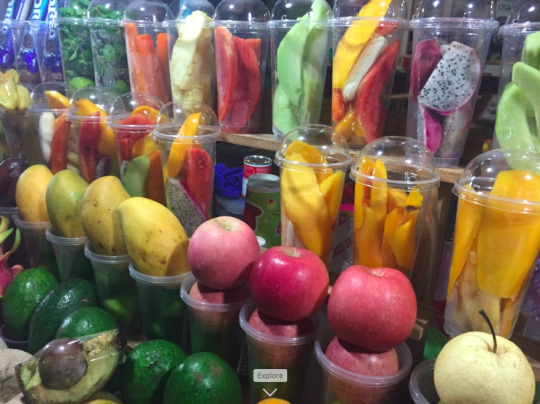
One of the Many Fresh Smoothie Stands in the Market
We spent the remainder of the evening browsing the night market, sampling spicy Laotian dishes at the food stalls along the street, and enjoying passionfruit smoothies. It was a great first day in Laos, and I was lucky to have equally terrific company with Tonya!
Day 162 – Luang Prabang
After grabbing breakfast at our hostel and befriending a few other travellers, Tonya and I headed out to explore town, passing first through the morning farmer’s market just along the street outside. The vendors start setting up before sunrise, and it was already busy as we walked through around 8:30am. Local produce and the catch-of-the-day were set up for sale on mats on the ground. Ready-to-eat snacks were also for sale, such as charcoal-grilled honeycomb, baelfruit, mung-bean rice cakes, Mok Pa (a dish cooked with catfish caught in the Mekong), Lao Khao Soi, various meats cooked in banana leaf, Khao Jee Pate (a Laotian take on a Banh Mi Baguette sandwich) barbecued frog, water buffalo sausage, coconut milk pancakes, young coconuts, various noodle dishes, and even grilled rat – just to name a few snacks! We enjoyed stolling along the street, chatting with the friendly vendors, and taking in the vibrant colours, sights and smells of the market.
We continued onwards to the bank of the Mekong River, lined with palm and banana trees. Long, shallow river boats churned through the milky brown water below. Beyond the wide, lazy river, we could see lush green mountains in the distance. As we walked along the embankment, various tour operators approached us, trying to sell us tours in these slow riverboats. While we were certainly interested, Tonya and I had done our research on reputable tours, and planned to purchase our trip up the Mekong for the following day.

Drying Orange Robes in a Monastery in Luang Prabang
Turning inland, we began to meander along the quieter streets of town, lined with traditional Lao houses and guesthomes, many of which were constructed with bamboo materials during the colonial period. The UNESCO protections in the town continued to be evident, as there were no high-rise buildings or large tour buses anywhere in the town centre. Tuk-tuks and scooters were by far the most common means of transportation for locals and visitors. As we walked, we occasionally passed some active Buddhist monasteries, and while we could not enter, we could see the laundered orange robes of the monks hanging out to dry.

Wat Xieng Thong
We visited one of the best-known monasteries in the town centre, Wat Xieng Thong. Dating back to the 16th century, the temple complex housed a gilded ordination hall, with large, sweeping roofs, along with numerous stupas, chapels, a library, a drum tower, and a funeral carriage - historically used to carry the urns of Lao royalty. The architecture throughout Wat Xieng Thong was simply stunning, with every structure richly decorated with engravings, colourful mosaics, paintings, gilding and elaborate sculptures.
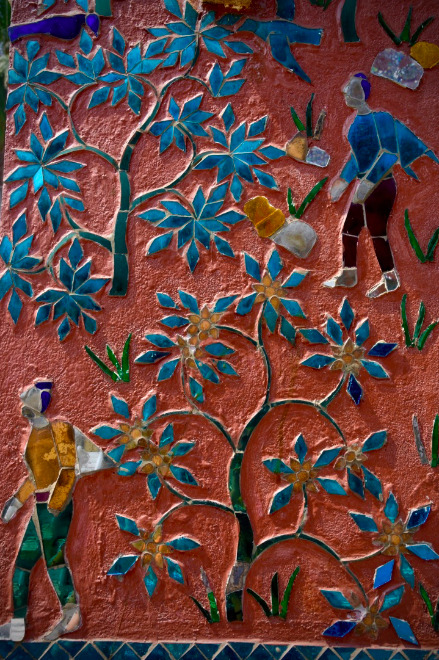
A close-up of mosaics at Wat Xieng Thong
Ready for some shade and bite to eat, Tonya and I headed to the banks of the Nam Khan River, crossing a bamboo footbridge to the far bank. The bamboo bridges of Luang Prabang are built by local families on an annual basis, facilitating the journey to and from the old quarter of the city. Incredibly, though these bridges are solely built from bamboo and rope, they are very sturdy! As visitors to Luang Prabang, Tonya and I paid a small toll to cross the bridge, which contributes to the upkeep and annual bridge replacement.
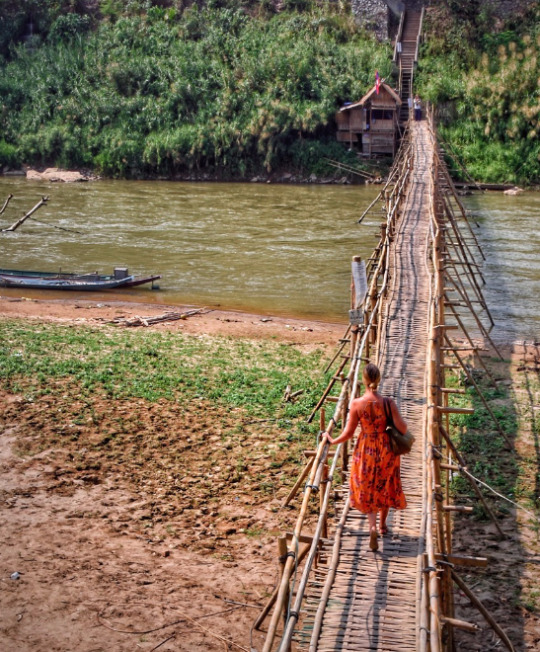
Bamboo Bridge across the Nam Khan River
On the far banks of the river, we arrived at Dyen Sabai – a restaurant recommended by a friend of mine from Western, Brandon - who had briefly lived abroad in Laos, and had generously given me all sorts of local recommendations! He had highly recommended that I visit Dyen Sabai for their Lao Buffalo Fondue. The setting was peaceful – Tonya and I sat on low futons at a riverside table, surrounded by a beautiful bamboo garden. The buffalo fondue dish turned out to be cooked in a similar way to Chinese hot pot/Korean BBQ. The servers prepared a small charcoal fire in a metal container built into the table, before placing a specialized cover overtop. This set-up allowed Tonya and I to cook the meat ourselves on the grill and cook the vegetables in the broth. It was a delicious (and interactive!) meal, a recommendation well worth it.
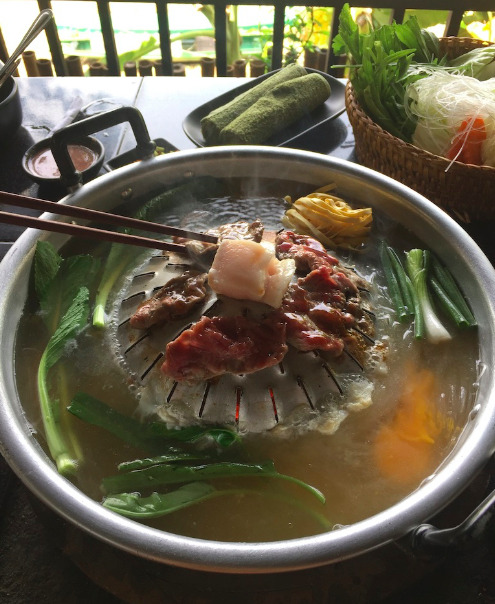
Buffalo Fondue at Dyen Sabai
After lunch, we traversed back over the bridge, and walked along the banks of the Nam Khan river to Utopia, a outdoor bar and bucket-list destination for any backpacker to the area (I think I had about 10 different friends recommend I go!). Tonya and I spent several hours of the late afternoon enjoying several Beer Lao while sitting on the floor cushions, chatting with other travellers and taking in the incredible ambiance of this lively riverside bar.

Nam Khan River
As evening began to fall, we returned to the town centre to climb Mount Phousi for sunset. A small mountain located in the heart of the historic town centre, Phou-si literally translates to “sacred hill”, and stands approximately 100m tall. While it was a bit of a climb to the top, I was happy for the exercise! Along the trail as we ascended were many gilded statues of Buddha, with a small temple and golden stupa at the summit. Arriving just on time for sunset, we took in an incredible 360-degree view of Luang Prabang, the Mekong River shimmering in a deep shade of orange, reflecting the mesmerizing sky above. The distant mountains were blanketed in a smoky haze from the burning of brush and farmers fields. While the hill was packed with tourists who had the same idea as us – it was still a wonderful way to end a day of exploring the city. Ready to tuck into some more of Laos’ famous street food, Tonya and I returned to the night market along Sisavangvong Road, taking in the brightly lit red and blue booths framed by tall palm trees and the opulent Royal Palace. After sharing and sampling countless delicious dishes, we headed back to our hostel, stopping at a booth on the main road to purchase tickets for our boat trip up the Mekong River the following day. I crashed almost immediately, as I was planning to wake up before dawn to view the morning Almsgiving ceremony, a daily tradition of local Buddhist monks.

Sunset from Mount Phousi
1 note
·
View note
Text
Gooooooood morning Vietnam
It’s actually over 3 years since I went to Vietnam, better late than never in writing up about it! This trip was March 2017.
I had a direct flight from London to Hanoi with Vietnam Airlines, an extremely reasonable flight price of around £450 return if I remember rightly. After a 12+ hour flight, I landed at 4.30am local time, and after swiftly clearing immigration (British citizens didn’t – at time of travel – require a visa for stays under 15 days) I had quite a long wait for my bag as it was basically the last one round the carousel – always a slightly worrying time! I’d arranged a transfer to my hotel in central Hanoi, and after arriving at the hotel at around 6.30am I took myself off to bed. Top tip, especially when travelling somewhere where accommodation is cheap by western standards – if you are arriving somewhere first thing in the morning, book a hotel room for the previous night so you can check in and either get some kip for a few hours, or freshen up before you start exploring. The hotel I was staying in was approx £30 per night which was worth every penny to be able to crash for a few hours.
As it turned out, I was absolutely knackered, the product of being in a job I didn’t enjoy (part of the reason I’d gone on sabbatical the year before), and at the time I’d actually just been successful in interviewing for another job in the same company which I would start shortly after returning from this trip. Much less stress and a better work/life balance, but that isn’t the topic of this blog, and as such I pretty much slept through the entire day. Fortunately I’d arrived a day early to join the trip so I didn’t miss out on that much, and it gave my body clock a chance to adjust.
After a long sleep, I awoke refreshed on the second day and after breakfasting in the hotel, I set off exploring Hanoi. One thing I had been warned about prior to this trip was that attempting to cross the street in Hanoi would be an interesting experience, certainly if you waited as you would in the U.K. for a break in the traffic, I’d still be stuck on the wrong side of the street now! It is a little unnerving basically having to walk out into traffic but, unbelievably, it works. Most people in Vietnam ride scooters as the taxes on (usually imported) cars are prohibitively expensive, and they are used to adjusting their speeds for pedestrians. After building up confidence to cross the street, I made my way to Hoan Kiam Lake and walked around it, enjoying the early morning sights including the locals enjoying some early morning yoga/meditation along the shores.
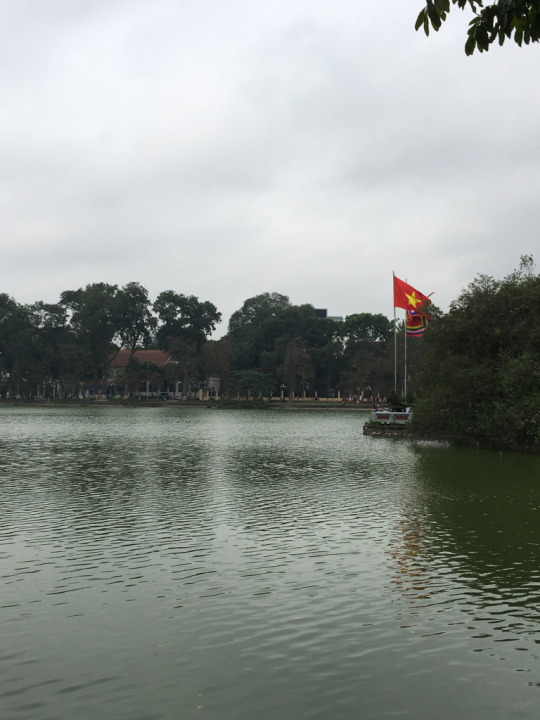
Hoan Kiam Lake, Hanoi
After some more wandering to a temple and to the market, I headed back to my hotel for some much needed air-con. After a short break from the heat, I ventured back outside and grabbed lunch – a delicious Bánh Mì from Banh Mi 25, one of the top-rated places for Bánh Mì in Hanoi. Bánh Mì are a delicious fusion sandwich, a baguette-style bread roll filled with pate, grilled meat, cucumber and pickled veg, and an absolute bargain with a Bánh Mì and bottle of water costing the equivalent of 75p!
In the afternoon I walked to the Ho Chi Minh mausoleum complex and around the botanical gardens before retreating back to the hotel. In the evening I met the rest of the group (a G Adventures trip) and we headed out for dinner.
An early start the next morning as we headed to Halong Bay. It was a 4 hour drive punctuated by a stop at a project which creates employment for disabled people by teaching them crafts and needlework which is then sold. A very interesting idea.
We arrived at Halong Bay and boarded our overnight junk boat in time for lunch. As we set sail through the bay, the limestone karsts that we passed through reminded me a little bit of Milford Sound. I’ve since also been to Khao Sok in Thailand which was very reminiscent of Halong Bay. We sailed through the bay in the afternoon, stopping off in a couple of places including Ti Top Island where we climbed up 400 steps to take in the views.
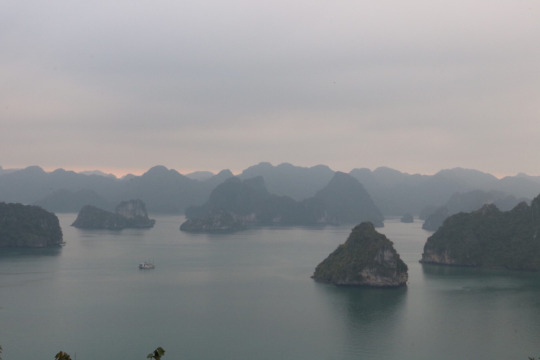
Halong Bay
We had dinner on the boat, all freshly made on board and plate after plate of delicious food was served up. After enjoying the stars with a couple of drinks, I retreated to bed. Another early start the following morning with breakfast at 7am before we visited a Sung Sot Cave, the largest cave in Halong Bay, which had this amazing, wave-like ceiling.
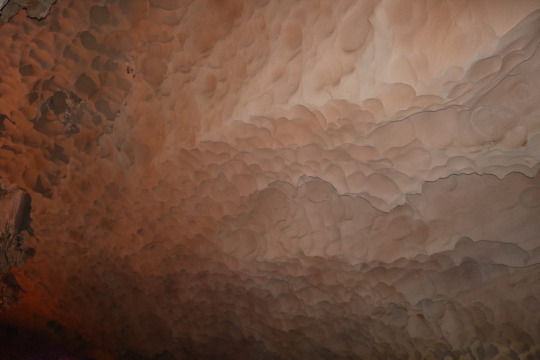
Sung Sot Cave, Halong Bay
We then headed back to land and late morning got off the boat and headed on the 4 hour journey back to Hanoi. We were taking the overnight train south to Hue but had a few hours spare before then, so I went on a street food tour. If you haven’t already gathered, I absolutely loved the food in Vietnam. I think it’s the best food I’ve had anywhere, and certainly the cheapest. We wandered the streets of Hanoi, sampling lots of delicious food before ending up in Hanoi Food Culture where we had the Vietnamese speciality of egg coffee (or egg chocolate in my case as I’m not a coffee drinker)
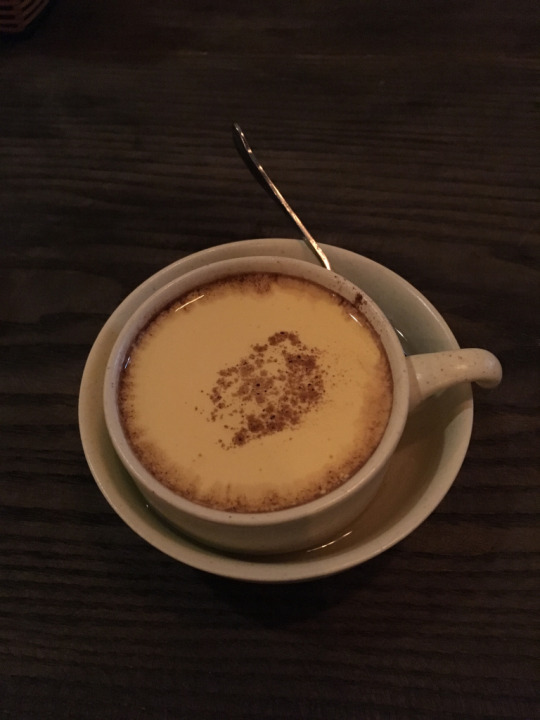
Egg chocolate – an alternate version of the Vietnamese speciality egg coffee
We boarded the train in the evening, around 9pm. We were travelling in first class which comprised of 4-berth bunks with shared toilets/squats at the ends of the carriages. Second class was 6-berth bunks, followed by soft seats and hard seats (as you might recall from the Top Gear Vietnam special). I took a top bunk. The journey itself was very loud and the train was very shaky, and I don’t remember sleeping too much. The overnight train I’ve since been on in Thailand was a much more comfortable ride.
We arrived in Hue at 10.30am the next morning. It was noticeably hotter and more humid. Despite arriving early, we were able to check in to our hotel where I promptly showered before heading out for a quick wander before we went on our included trips in the afternoon. I ventured for a walk along the Perfume River before retreating to the air con ahead of our afternoon tours. Firstly we went to the Tien Mu Pagoda:
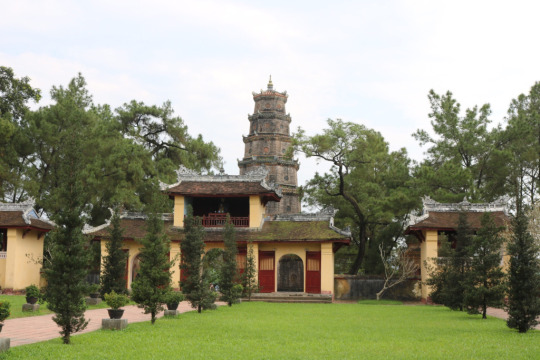
Tien Mu Pagoda, Hue
We then went to the main attraction in Hue, the Imperial Citadel. An imposing collection of buildings, and much, much larger than I imagined. The citadel was built in the early 1800s and was targeted during the Vietnam War. You can see the bullet holes from the Vietnam War in some of the walls.
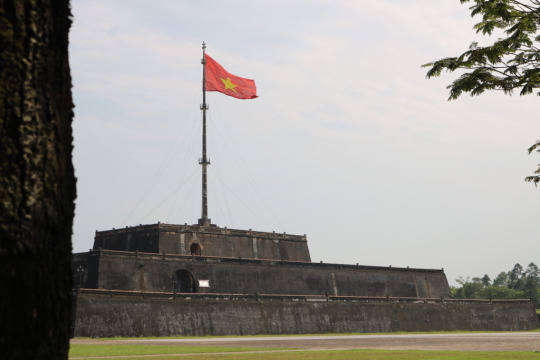
Imperial citadel, Hue
We also squeezed in a visit to the Royal Tombs on an busy sightseeing afternoon.
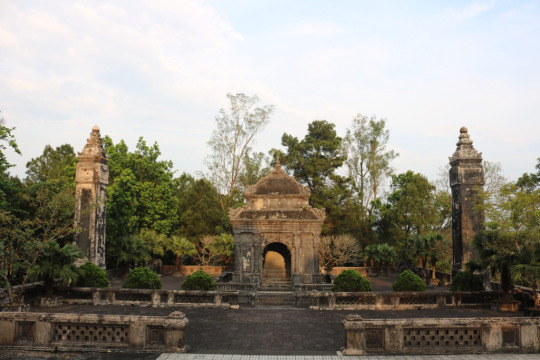
At the Royal Tombs, Hue
The next morning I did a motorbike tour (as backseat passenger!) – an absolute must-do in a country where motorbikes/scooters are the primary form of transport. We were taken out to the countryside outside of Hue, seeing rice fields, monasteries and a colosseum where elephants and tigers once fought. We had an included vegetarian lunch at the monastery which was, once again, absolutely delicious.
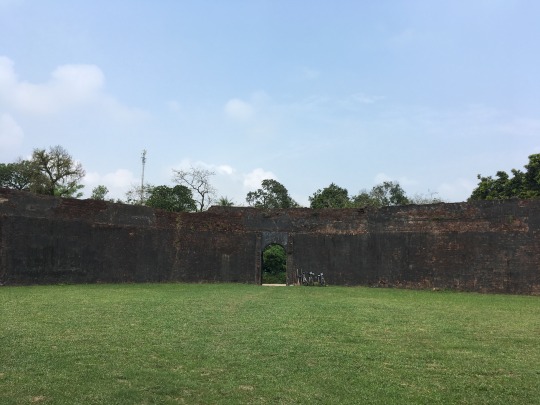
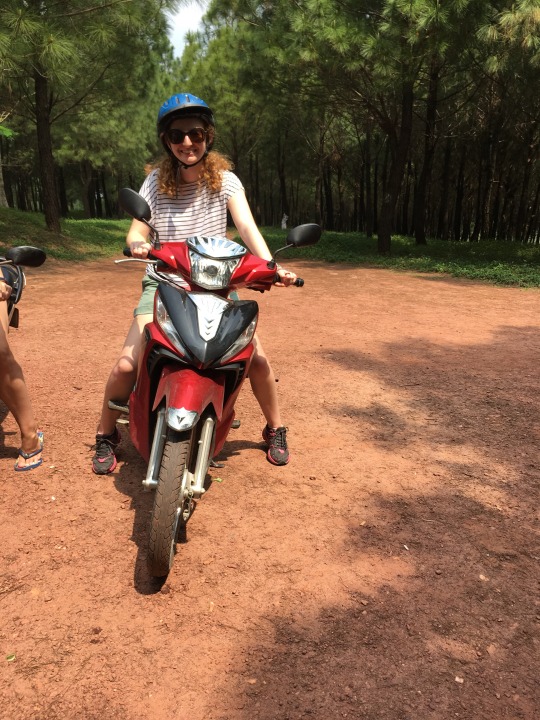
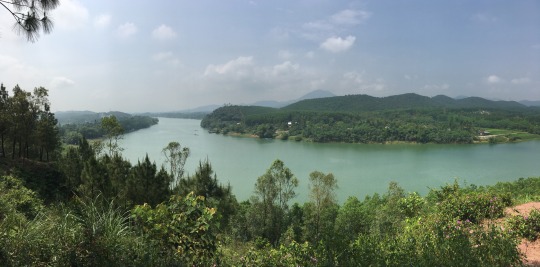
Colosseum; Biker pose; River views
We arrived back in Hue after lunch and then headed south over the Hai Van Pass towards Hoi An. Unfortunately it was a bit cloudier than ideal which didn’t make for the best photos, but we still saw some great views.
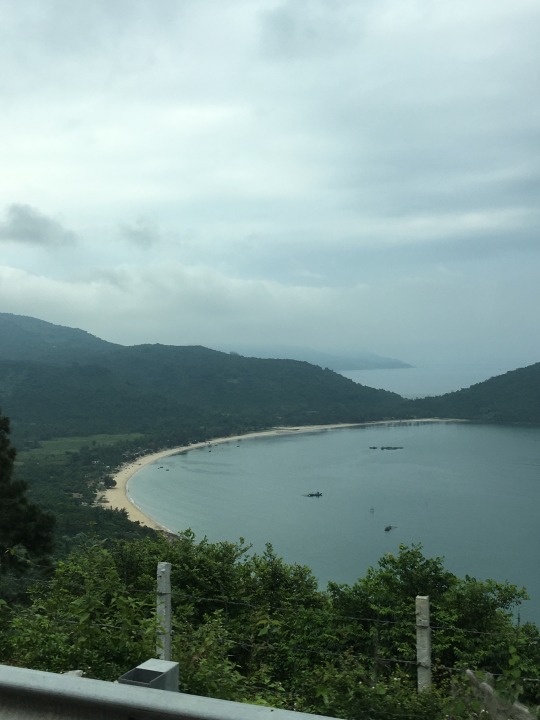
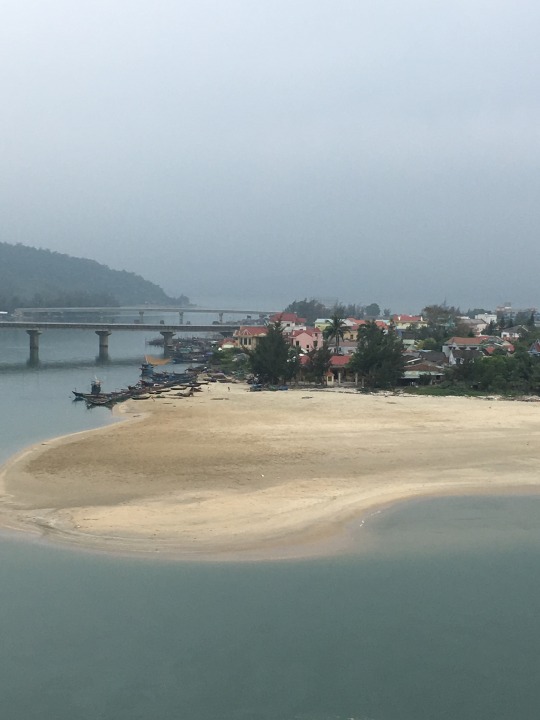
Views on the drive to Hoi An.
We arrived in Hoi An in the late afternoon. Our guide took us on a brief orientation tour as we had 3 nights here to explore. We bumped into Jack Whitehall and his dad filming their Netflix travel series whilst we were wandering down tailors row – an unexpected sight! Hoi An is famous for getting cheap tailoring which can be ready in as little as 24 hours, but I didn’t partake on this occasion.
The following day we had an included excursion in the morning to Planeterra’s project here, Oodles of Noodles. This project taught local kids both the skills of cooking in a professional environment, as well as some English language. We learned to make rice pancakes, and then enjoyed a delicious bowl of noodles for lunch:
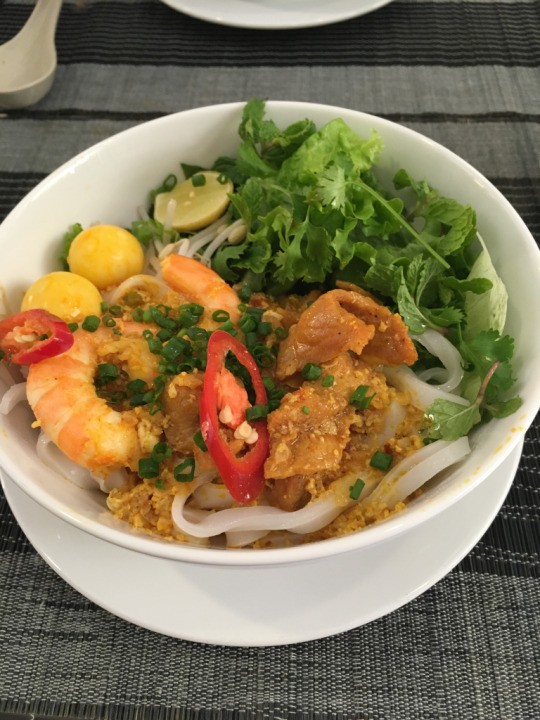
Lunch at Oodles of Noodles, Hoi An
We had a free afternoon where I enjoyed walking around Hoi An old town. Sincerely the prettiest place I’ve ever been.
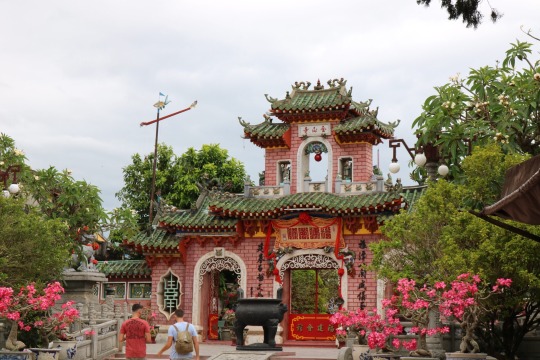
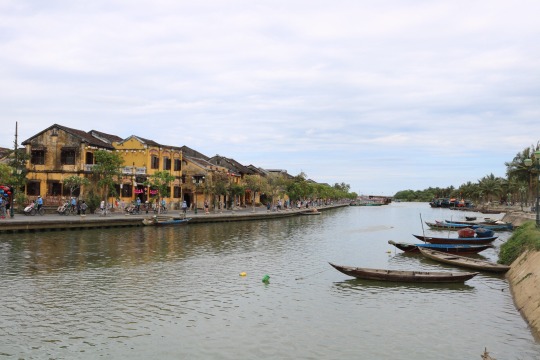
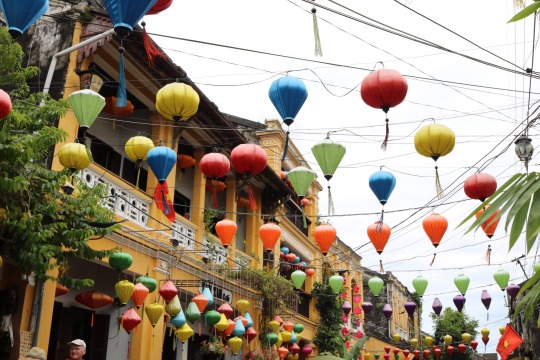
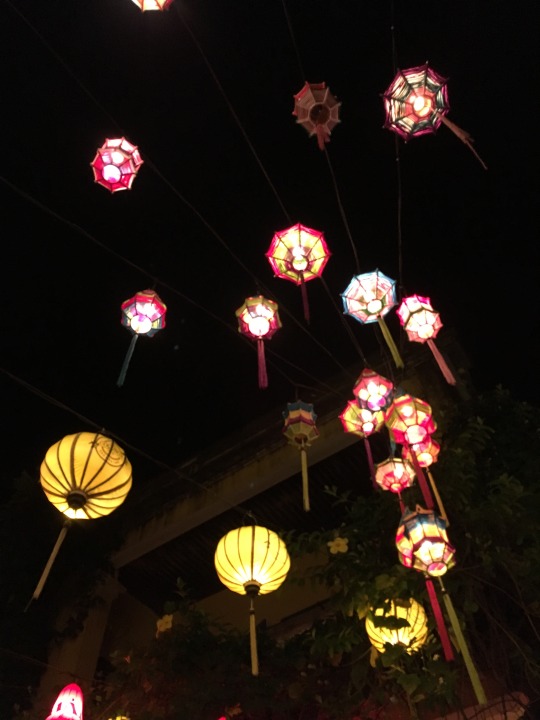
Sights of Hoi An, the prettiest place I’ve ever been
The next day was a free day. The weather was a bit dodgy, grey with the occasionally downpour but still very warm, so after a relaxing morning at the hotel, I went for a hot stone massage in the afternoon. £20 for a 90 minute massage was an absolute bargain, even if I was a bit sore the following day! In the evening we enjoyed a walk (and some bargains) in the night markets.
The next morning was an early start for a flight from nearby Danang to Ho Chi Minh City (HCMC), formerly Saigon. Even hotter and more sticky than Hue. After checking in to the hotel mid morning, and then going for lunch to have pho (finally!), we then had a free afternoon. Ho Chi Minh City has some pretty spectacular architecture, including many remnants of the French colonial era:
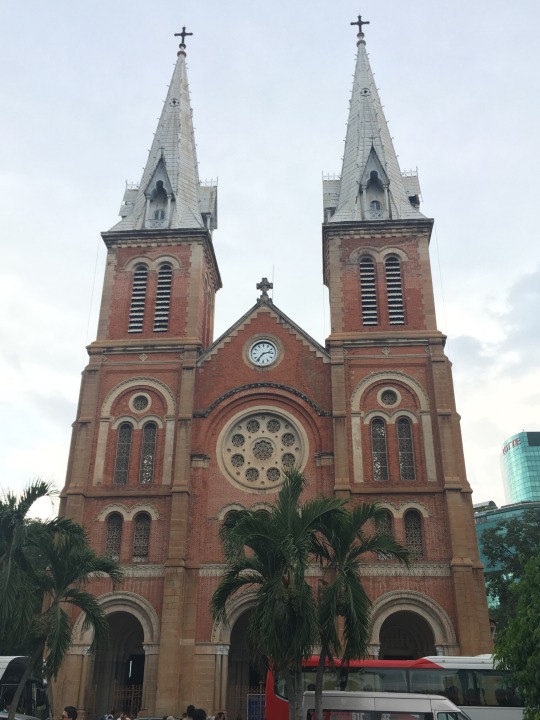
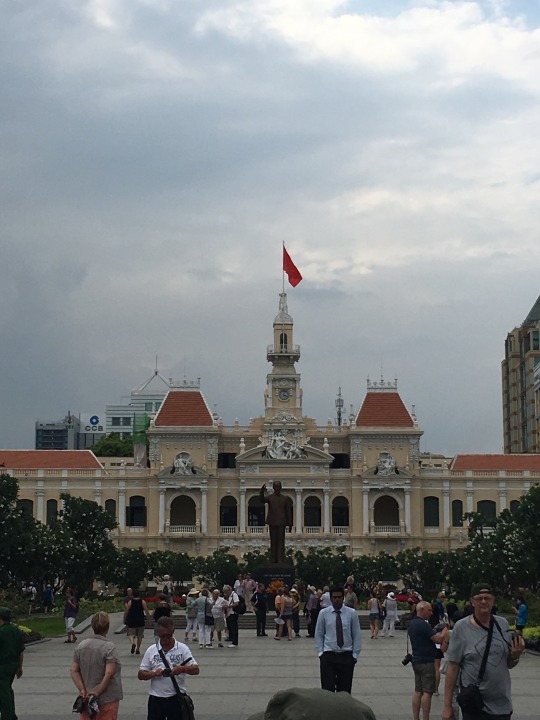
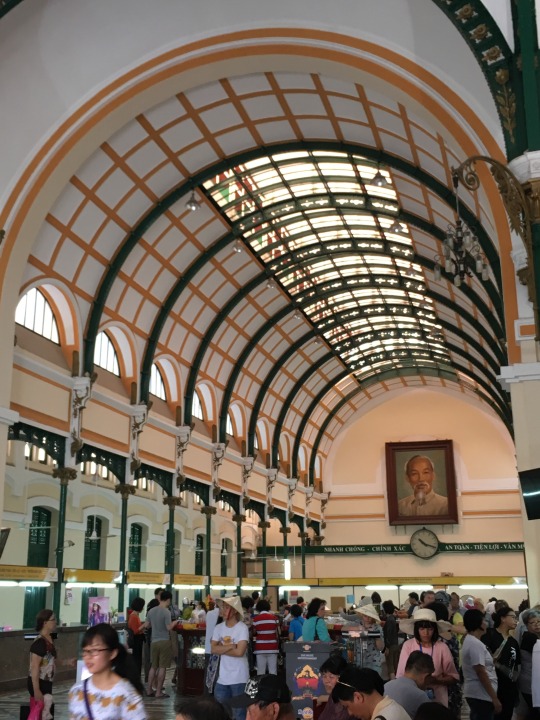
Notre Dame Cathedral, HCMC; City Hall; The Post Office, HCMC
The following day we had an included trip out to the Cu Chi Tunnels, a network of tunnels built by the Viet Cong outside of Saigon during the Vietnam War. It was fascinating to learn about the guerilla tactics used by the Viet Cong, and amazing to see the size of the tunnels, which were utterly minuscule.
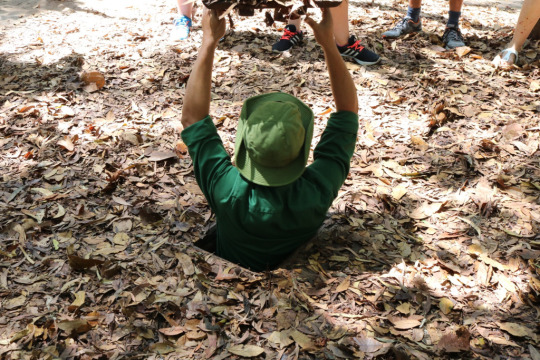
Cu Chi Tunnels, barely big enough for a body to fit through
We came back to HCMC for lunch and then had a free afternoon. I decided to go to the War Remnants museum which is is a sobering affair. Be warned – there are some very graphic pictures of the effects of the chemical warfare. It was also horrifying to learn that people still live with the effects having been exposed at the time, but also because some of the effects can be passed on to offspring. A sobering reminder of the legacy of war, and well worth a visit.
That evening was our final group dinner before I left the following day. More delicious food, this time Vietnamese barbecue.

Vietnamese BBQ – cook your own dinner!
I had most of the next day free before an evening flight back to London via Hanoi. It was extremely hot and sticky again, and after a walk in the morning to the Reunification Palace and a failed attempt to find the Jade Emperor Pagoda, I retreated back to the hotel and air con and a shower before heading to the airport in the late afternoon.
So, what were my impressions of Vietnam? Genuinely part of the reason I went was after I’d seen the Top Gear Vietnam show, it looked a beautiful and fascinating country. A few people I’d met on my previous travels had also been and talked about what a wonderful country it is. And it certainly was. Everyone was friendly, I didn’t feel afraid walking around by myself, a solo female traveller (albeit on a group tour). It was very cheap – obviously I’d paid for the trip and accommodation/transport beforehand, and so all I had to buy whilst there was food, drinks, excursions and souvenirs. I was there for 10 days and spent less than £150 – and that included a $40 motorbike trip and a £20 massage. The absolute best food I’ve had anywhere I’ve been either before or since (with Peru close behind). And a fascinating, and devastating, recent history. Would absolutely recommend, and when I do go back again to South East Asia, I wouldn’t think twice about going back.
from WordPress https://catsgreatadventure.wordpress.com/2020/07/25/gooooooood-morning-vietnam/
1 note
·
View note
Text
Goodnight Saigon, It's a Holiday in Cambodia
We spent our final hours in Vietnam this morning. What a country. We gorged on our hotel breakfast, eating as if we would never see such great fruit ever again. While we knew that wasn't true, "The Myst Dong Khoi" hotel treated us right and made our stay in Ho Chi Minh City extra special.
We made one final stop at the Ben Thanh market. Alex picked up his suit. It looked AMAZING. We also grabbed over a kilogram of mango candy to take home for family, colleagues, and students to enjoy. On our way out, we picked up a quick snack of Banh Gio, which we thought was sticky rice. But we were wrong! It was a steamed rice cake stuffed with pork and other stuff that we weren't sure quite what it was. But it was tasty! The whole thing came wrapped in a big banana leaf and cost less than a dollar. Amazing country.
We got our snack mostly to kill time because we just had to go back to Banh Mi Hyunh Hoa for a sandwich for the road aka our flight. The only meal (other than hotel breakfasts) that we had twice. We booked one last taxi to the hotel and relished in the fact that it was a Chevy Spark. It was a tender bonding moment to try and communicate with our driver, explaining that we had the same car. "It's cheap!" He said. We all laughed. It's funny because it's true.
We packed up, and left Vietnam. When we arrived, we realized we made a near-fatal mistake. We actually never confirmed our flight out of HCMC to Cambodia. It was a close call, but we actually bought tickets that afternoon, for a flight scheduled to leave three hours later! Oopsies! But it all worked out as we boarded the flight to Cambodia.
The flight took less than an hour, and was fairly smooth. Our seatmate came from Arizona but actually grew up in Poughkeepsie, NY! Small world. We landed on a wide runway and walked into a unique airport that adopted Indochinese architecture, not unlike our previous hotel. We thought a car was waiting for us outside, but no, it was a motorized Tuk Tuk! We rode on the back of a cart, zooming through the Cambodian night. It was not what we expected. We expected a city but Siem Reap is quiet and rural. We were so used to such loud noises and cars so it was a bit of a shock to be in such a quiet place.
We began our stay at the Baby Elephant Boutique Hotel, a wonderful Cambodian resort that resembled a bed and breakfast more than anything else. We were served welcome drinks, as well as attention from Happy, the four-legged welcome committee. He was very friendly! Once we unpacked in the room it was time to go back out into town for dinner. Siem Reap is not a culinary destination, however, there was a Khmer restaurant on the top of every Internet list, and was the only restaurant we saw with a wait.
The homely restaurant had about thirty tables in it's open air concept, and the wait staff, made up of young women, all were incredibly friendly and happy to have customers. We ordered two traditional dishes: Amok, a green curry with lemongrass and Thai basil flavors, served in a banana leaf, and Lok Luk, a saucy mix of beef, veggies and a fried egg, accompanied with a peppery sauce. We rounded our order with a Cambodian beer and ate quickly. The food was delicious and flavorful, giving us a good feeling of what Cambodia could possibly offer. Even if it wasn't half as good as our banh mi from earlier, we cleaned our plates, and saved room for dessert. Mango sticky rice! The mango was soft and chewy. The rice was sweet. It was a terrific end to the meal.
We took a roundabout way back to the hotel, hopping into the market, where we picked up some of the peppercorns that made up the Lok Luk sauce, and then peeked into "pub street," which was Siem Reap's version of Bourbon Street.
We had heard about crowds in Cambodia but the only signs of life came on Pub Street. This city, if we can call it a city, has been decimated by COVID, as lockdowns eviscerated the flourishing tourism scene, which seems to be recovering slowly. Everyone spoke English here and most of the restaurants served Western food. It's more common to see pizza instead of curry, and any hint of traditional Cambodian cuisine has been painted over by Thai flavors to give the customers a taste they may be more familiar with. It's not the most heartening sight to see in a country that has already endured hardship, tragedy in the form of its own genocide, but the draw to Siem Reap is not the food or nightlife, but the temples, which we will get up to see tomorrow.
Alex: Rach we made it to the Kingdom of Cambodia. The doorway to the ancient wonders of the world. How do you feel? It's a little different here than the big city, huh?
Rachel: Very different. I think that we are staying a little further from many of the huge hotels and it feels very very rural. It's not true because just a half mile away is the downtown area of Siem Reap. With that being said, the downtown area has less people than any given block in Ho Chi Minh City.
A: While this is like a big change, I actually think it's a blessing in disguise and we'll have a lot of space tomorrow to relax and go to all the temples and not have to wade through crowds.
R: I am VERY excited to see all the temples and add another wonder if the world to my very short list.
A: This is the second ancient civilization we'll have visited together, the first being Mayan temples in Belize. I liked how we got to climb those steps and hope we can have a bit of a hands on experience to really feel immersed in the spiritual atmosphere. Everything about the Cambodian and Khmer civilization has been fascinating to me.
R: And I was happy that we could start it all with Khmer food, including a delicious curry, a unique tomato dish, and finishing off with some mango sticky rice too.
A: While I know the food won't be as good as Vietnam I know our experience tomorrow will really make up for it.


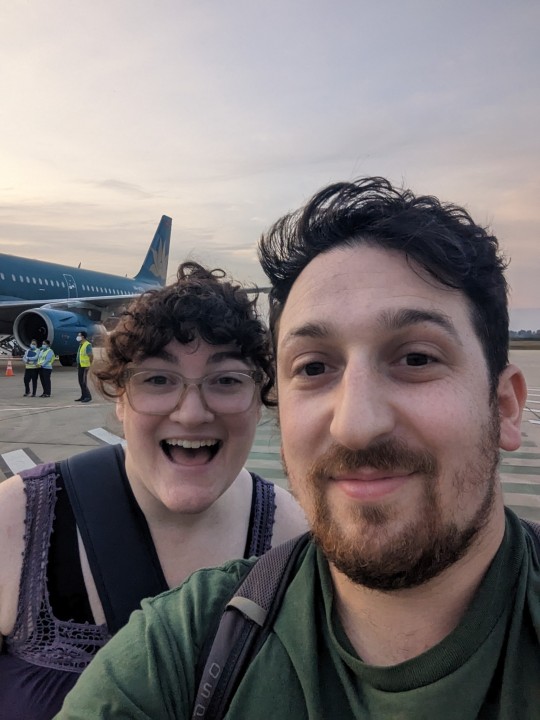
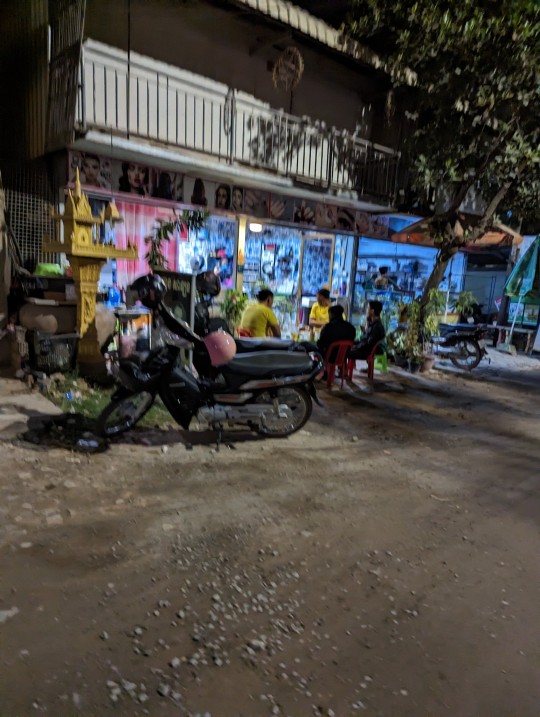





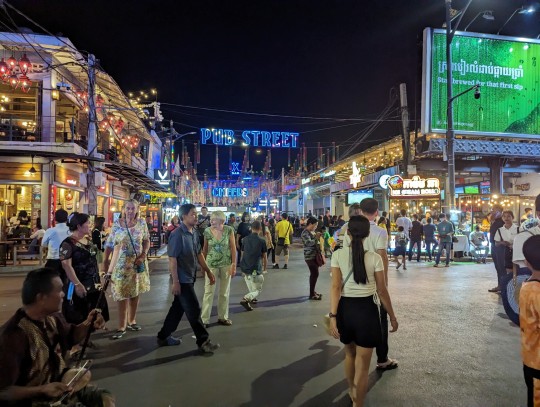
0 notes